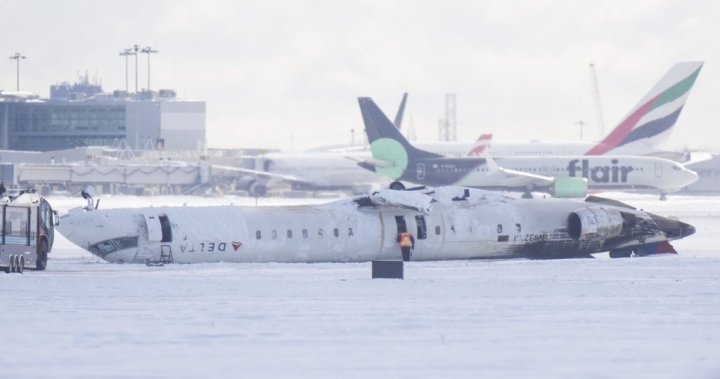Canada
44 seconds of mayhem: Video of Delta jet’s landing reveals clues about Toronto crash

A Harrowing Crash: Delta Air Lines Jet Suffers Landing Gear Failure at Toronto’s Pearson International Airport
On Monday, a Bombardier CRJ-900 regional jet operated by Delta Air Lines crashed at Toronto’s Pearson International Airport, leaving 21 people injured, including a child. The aircraft, which was carrying 76 passengers and four crew members, flipped onto its back after a hard landing, causing significant damage. Videos of the incident, which began circulating on social media, show the dramatic moments leading up to the crash, with the plane’s right main landing gear appearing to collapse under the force of impact. A veteran pilot, who has extensive experience flying the CRJ aircraft, analyzed the footage and suggested that the crash may have been caused by a combination of a high vertical speed approach, a hard landing, and a potential failure to perform a critical maneuver known as a “flare.”
The pilot, who chose to remain anonymous, explained that the video footage shows the aircraft approaching the runway at a higher speed than usual. He noted that the flight crew did not appear to execute a flare—a standard procedure where the nose of the aircraft is gently pitched upward to reduce vertical speed just before touchdown. This lack of a flare, combined with strong crosswinds, may have contributed to the hard landing and subsequent gear failure. The veteran pilot also pointed out that the right wing struck the ground at high speed, leading to a violent impact that sheared off the wing and caused the aircraft to flip onto its back.
The Role of Crosswinds and Pilot Decision-Making
The veteran pilot suggested that the Delta pilots may have been battling challenging weather conditions, including strong crosswinds, at the time of landing. These crosswinds could have forced the pilots to focus primarily on keeping the aircraft centered on the runway, potentially making the flare a secondary priority. However, the pilot emphasized that the inability to slow the aircraft’s vertical speed remains a critical question. He noted that the absence of a clear flare maneuver raises concerns about why the aircraft’s descent wasn’t better controlled, especially given the high speed at which it approached the runway.
Passengers who survived the crash corroborated the pilot’s assessment, describing the landing as unusually hard. They reported feeling a violent jolt as the aircraft touched down, followed by a loss of control and the plane flipping onto its back. The veteran pilot explained that the right wing’s shearing off and the subsequent flipping of the aircraft may have been a tragic but ultimately lifesaving outcome. He suggested that the fuel stored in the right wing was likely spilled onto the tarmac rather than igniting, which could have prevented a catastrophic fire.
A Lifesaving Twist: The Aircraft Flips but Fuel Fire is Averted
The veteran pilot highlighted an unexpected and potentially lifesaving consequence of the crash: the aircraft’s fuel tanks were likely ruptured in a way that prevented a large-scale fire. A CRJ-900 can carry up to 18,000 pounds of jet fuel, with significant portions stored in the wings. When the right wing sheared off during the crash, the fuel in that tank would have spilled onto the ground rather than catching fire. Had the aircraft remained upright, the fuel could have ignited, leading to a much more dangerous situation for the passengers and crew.
The pilot noted that the left wing remained intact, which may have contributed to the aircraft’s tendency to flip onto its back. He explained that the left wing, still producing lift, created an imbalance that pulled the plane upward and onto its back. While this was undoubtedly a terrifying experience for those on board, it may have ultimately reduced the risk of a deadly fire.
The Investigation Begins: Black Boxes Hold Key Answers
The Transportation Safety Board of Canada (TSB) has launched an investigation into the crash, with assistance from the National Transportation Safety Board (NTSB) in the United States. The veteran pilot expressed confidence that the investigation will provide clarity on the causes of the crash, thanks to the recovery of the aircraft’s two black boxes. One of these devices records flight data, while the other captures cockpit communications, including interactions between the pilots and air traffic control.
Given that the aircraft’s fuselage remained largely intact, the black boxes are likely in good condition and have already been analyzed. The pilot emphasized that regional airline pilots are among the most skilled and dedicated aviators in the industry, and he stressed that they may not have been at fault for the incident. Instead, he suggested that the crash may have been the result of a combination of challenging conditions and unavoidable circumstances.
The Broader Implications for Aviation Safety
The crash at Toronto’s Pearson International Airport serves as a stark reminder of the complexities and risks inherent in aviation. While the incident was tragic, it also underscores the resilience of modern aircraft and the sometimes heroic efforts of pilots to protect their passengers. The veteran pilot’s analysis highlights the critical role of small decisions—such as whether to execute a flare—in determining the outcome of a flight.
As investigators work to piece together the events leading up to the crash, their findings will be crucial for improving aviation safety and preventing similar incidents in the future. For now, the survival of all 76 passengers and four crew members is a testament to the strength of the aircraft and the training of its crew. The crash also serves as a reminder of the importance of rigorous safety protocols and the need for continued vigilance in the aviation industry.
By sharing his expertise, the veteran pilot has provided valuable insights into the possible causes of the crash, while also emphasizing the challenges faced by pilots in high-pressure situations. His comments, combined with the ongoing investigation, will help shed light on this dramatic event and its implications for air travel.











